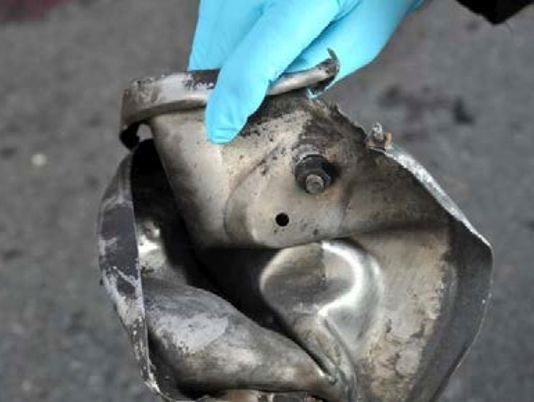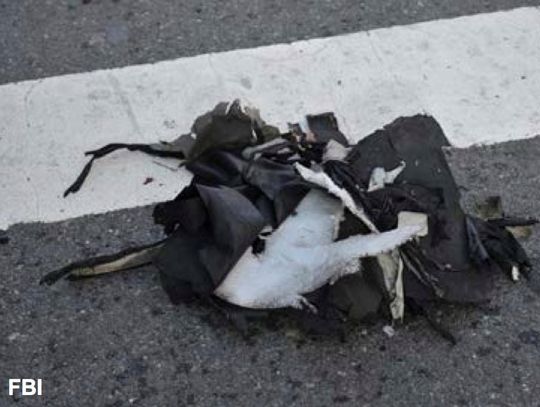 This image shows the remains of a pressure cooker that the FBI says was part of one of the bombs that exploded during the Boston Marathon. The FBI says it has evidence that indicates one of the bombs was contained in a pressure cooker with nails and ball bearings, and it was hidden in a backpack.(Photo: FBI via AP)
This image shows the remains of a pressure cooker that the FBI says was part of one of the bombs that exploded during the Boston Marathon. The FBI says it has evidence that indicates one of the bombs was contained in a pressure cooker with nails and ball bearings, and it was hidden in a backpack.(Photo: FBI via AP)
The explosive devices that killed three people and injured 176 at the Boston Marathon finish line were made from pressure cookers filled with metal and ball bearings and left in a backpack, according to a federal law enforcement official.
A joint bulletin issued by the FBI and Department of Homeland Security and containing photographs of a damaged pressure-cooker container was being circulated to law enforcement authorities in an effort to garner their assistance in tracking the source of the materials, a federal law enforcement official said.
The official, who spoke on the condition of anonymity because of the ongoing investigation, tells USA TODAY that investigators sifting through evidence at the scene found fabric fragments consistent with a black backpack, the official in Boston said.
The person said law enforcement officials have some of the bomb components but do not yet know what was used to set off the explosives.Separately, another federal law enforcement official who was not authorized to comment publicly said that circuit board material that may have been used to as part of a timing device was also found at the crime scene.
The description of the devices coincides with observations earlier by George Velmahos, chief of trauma surgery at Massachusetts General Hospital, who said most of the injuries were "traumatic amputations" in which the blasts nearly blew off one victim's legs.
The explosions 12 seconds and 100 yards apart ripped into the crowds gathered Monday afternoon for the finale of the traditional marathon that wound through the streets of Boston.
Velmahos had said that all of the victims had "10, 20, 30, 40 pieces of shrapnel embedded in their bodies, mostly in their legs, but as high up as their necks." He had described the shrapnel as pea-size pellets and nails stripped of their heads.
 The FBI says it has evidence that indicates one of the bombs was contained in a pressure cooker with nails and ball bearings, and it was hidden in a backpack.(Photo: FBI via AP)A law enforcement official said earlier that the devices were believed to be assembled with gunpowder and ball-bearing-type material to serve as shrapnel. The official, who has been briefed on the matter but is not authorized to comment publicly, described the devices as "rudimentary'' but powerful.
The FBI says it has evidence that indicates one of the bombs was contained in a pressure cooker with nails and ball bearings, and it was hidden in a backpack.(Photo: FBI via AP)A law enforcement official said earlier that the devices were believed to be assembled with gunpowder and ball-bearing-type material to serve as shrapnel. The official, who has been briefed on the matter but is not authorized to comment publicly, described the devices as "rudimentary'' but powerful.
It was unclear whether the devices were remotely detonated or included timers, the official said, adding that no conclusions had been drawn on whether an organized group or lone wolf had been responsible for the attack.
The use of pressure cookers as an improvised explosive device is a technique commonly taught in Afghan terrorist training camps, according to a 2003 bulletin by the Department of Homeland Security (DHS).
"Pressure cooker bombs are made with readily available materials and can be as simple or as complex as the builder decides,'' according to the DHS bulletin. "These types of devices can be (detonated) using simple electronic components including, but not limited to, digital watches, garage door openers, cellphones or pagers."
The bulletin noted that cooker bombs were used in an attack on an airport in Nepal in 2002 and a foiled attack in India in 2003.
Investigators have not determined whether Monday's attack was committed by a foreign or domestic person or group, the official said. They are also examining whether the date has particular significance for a person or a group, the official said.
 Hundreds gather in Garvey Park in Dorchester near the home of Martin Richard for a candlelight vigil in honor of the victims of the Boston Marathon bombings. Credit: USA TodayAt a joint briefing by federal and local authorities, officials declined to discuss their investigation, other than to say they had no one in custody.
Hundreds gather in Garvey Park in Dorchester near the home of Martin Richard for a candlelight vigil in honor of the victims of the Boston Marathon bombings. Credit: USA TodayAt a joint briefing by federal and local authorities, officials declined to discuss their investigation, other than to say they had no one in custody.
Massachusetts Gov. Deval Patrick did say, however, that the two devices that exploded were the only ones involved in the attack. He said no unexploded devices were found.
The officials also said they were interviewing hundreds of witnesses and examining surveillance tapes around the time that the blasts killed three people and injured at least 176, including 17 in critical condition.
"This will be a worldwide investigation," FBI Special Agent Richard Deslauriers said Tuesday. "We will go to the ends of the Earth to identify the subject or subjects who are responsible for this despicable crime, and we will do everything we can to bring them to justice."
Meanwhile, police have searched an apartment in a Boston suburb in connection with the blasts. A law enforcement official told USA TODAY the search of a high-rise in Revere is related to a Saudi national viewed by police as a "lead" — not a suspect — in the investigation of Monday afternoon's deadly bombings at the race's finish line.
The Washington Post quoted U.S.law enforcement officials as also saying that Saudi male is being regarded as a witness, not a suspect.
Police, along with FBI and Homeland Security agents, descended on the Water's Edge apartment, removing brown paper bags, trash bags and a duffel bag among other items.
The official identified the man as a Saudi national. The man, like many at the time of the explosions, was observed running from the scene and sought medical treatment. The law enforcement official has been briefed on the matter but is not authorized to comment publicly on the case.
Other news organizations have reported that the individual, who was hospitalized with injuries, is a Saudi national in the United States on a valid student visa.
A federal law enforcement official Tuesday afternoon said any link between the Saudi national and the explosion is "washing out."
 Police and federal officials exit an apartment complex with a possible connection to explosions during the Boston Marathon.(Photo: Getty Images)At the news briefing, officials also appealed to the public to come forward with videos and photos of the scene of the bombing near the finish line of the Boston Marathon.
Police and federal officials exit an apartment complex with a possible connection to explosions during the Boston Marathon.(Photo: Getty Images)At the news briefing, officials also appealed to the public to come forward with videos and photos of the scene of the bombing near the finish line of the Boston Marathon.
Boston Police Commissioner Ed Davis said it was particularly interested in photos taken just before and just after the explosions.
DesLauriers, who is leading the inquiry, said additional forensic teams were being dispatched to the city to assist in analyzing streams of photo and video materials already seized by investigators.
Davischaracterized the 12-block crime scene around Copley Square as the "most complex in the history of our department.'' He said it would like take at least two more days to examine the area and collect evidence that may exist there.
The bureau of Alcohol, Tobacco and Firearms evidence recovery experts found blast debris on rooftops and embedded in nearby buildings. Officials are conducting a "grid" search for potential evidence.
 В Атырау -6
В Атырау -6